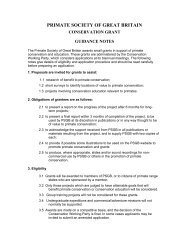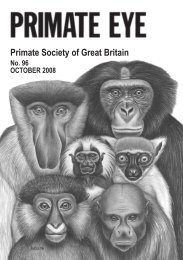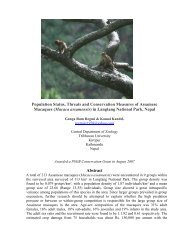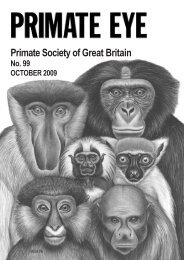2010 Vol 101.pdf (1.63mb) - Primate Society of Great Britain
2010 Vol 101.pdf (1.63mb) - Primate Society of Great Britain
2010 Vol 101.pdf (1.63mb) - Primate Society of Great Britain
You also want an ePaper? Increase the reach of your titles
YUMPU automatically turns print PDFs into web optimized ePapers that Google loves.
humans and such brain asymmetries may be a key component <strong>of</strong> human<br />
evolution. However, it is not clear how asymmetrical structures and<br />
functions are linked. One hypothesis for leftward language lateralization in<br />
Wernicke’s area is based on the asymmetry <strong>of</strong> vertical units <strong>of</strong> cells<br />
(minicolumns) in the cerebral cortex, where minicolumns are wider in the<br />
left hemisphere in humans but symmetrical in non-human primates. It is not<br />
known whether there is a similar species difference in the face processing<br />
region, the fusiform cortex. We investigated the fusiform <strong>of</strong> 14 human and<br />
14 chimpanzee post-mortem brains for species differences in minicolumn<br />
and cell size symmetry. Minicolumn spacing and neuron size were<br />
asymetrical* in humans (wider and larger on the left, respectively), but<br />
symmetrical* in chimpanzees (species differences p






